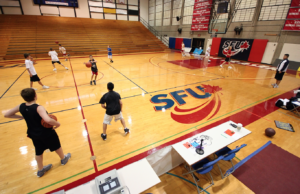Four principles for offseason basketball training
Another season is in the books, and by now you’ve had time to audit your program, your work and your players. The offseason is where programs create separation between themselves and their rivals. Long before teams cut down the nets next year or players showcase their improvements, the bulk of the work has been done.
 To me, there is no separation between preparing your body and mind from a performance standpoint or preparing your body and mind from a skill development standpoint; these go hand-in-hand. There are many players who never reach their potential as basketball players because their skill set fails to improve. On the flip side, there are players who have developed their skills but don’t have the strength, power or capacity to express those in competition. These steps will help teams improve their overall athletic performance.
To me, there is no separation between preparing your body and mind from a performance standpoint or preparing your body and mind from a skill development standpoint; these go hand-in-hand. There are many players who never reach their potential as basketball players because their skill set fails to improve. On the flip side, there are players who have developed their skills but don’t have the strength, power or capacity to express those in competition. These steps will help teams improve their overall athletic performance.
Start by looking at the big picture of where you currently stand and where you’d like to go. In my opinion, true development happens in the space between the everyday grind. Anyone can learn the how, but it’s a matter of doing the work. Here is a foundational structure of my training programs:
- Test. Objective measures and feedback.
- Train. Build and follow specific training plans.
- Track. Measure your progress.
- Compete. Test your progress in game like situations.
Test
The biggest change in my programming has been inserting weekly testing into our training. For teams or athletes, I suggest picking one or two areas of desired improvement for a given amount of time and progressing from there. This gives athletes and coaches feedback on a regular basis, letting you know whether players are improving.
Our typical breakdown of testing consists of anthropomorphic measurements, movement patterns and performance capabilities. Ultimately, you’ll have to decide what’s important to you and build your training accordingly. With anthropometrics, I’m mainly looking at body weight and body composition, as I’m interested in relative power. My mission is to help build the best pound-for-pound players possible. Our training can be designed in such a way to maximize this potential.
The next layer is movement quality, and we use the functional movement screen to identify faulty movement patterns. We then dive into athletic performance qualities like strength, power and speed.For players, it’s important to be realistic about where you are, where you want to go and what you need to do to get there. Coaches should be specific in communicating what they want, and challenge players with specific goals and timelines.
Train
I think it’s more valuable to give you a template to build plans specific to your team as opposed to giving you an actual program, but I’ll share both. Nearly every training session has the same structure, including a warm-up, movement skills, power, strength and capacity work. FIGURE 1 illustrates specific criteria we use in choosing loads for our training sessions.

If you’re looking for a technical and foundational framework to build offseason training plans, here are the criteria that I use:
- Needs analysis. Done for both individual and program.
- Exercise selection. Priority should be on large muscle groups and multi-joint movements.
- Training frequency. Beginners two to three times per week; intermediate three to f our times per week; advanced four to seven times per week.
- Exercise order. Power, alternate upper/lower, alternate push/pull.
- Loads and repetitions. Think of this as intensity. As load goes up, reps go down.
- Volume. Total amount lifted in a session.
- Rest periods. This varies from 30 seconds to five minutes depending on training goal.
Players must be specific in their training. They can’t sit down and stand up at the same time. As for coaches, consistency is king. Give players the opportunity to train on a regular basis.
Track
One of the most powerful tools to communicate improvement is objective feedback. As the saying goes, a picture is worth a thousand words.
I encourage players and coaches to take before and after pictures, if possible. I want players to see tangible evidence of their improvements. Along the same lines, tracking training sessions gives everybody involved a sense of how players are progressing from a purely objective point of view.
Players and coaches must know what is expected and they must be accountable for the work, or lack thereof.
When tipoff arrives next season, the work has already been done in the hours, days, weeks and months during the offseason. More than anything, results speak for themselves.
Henry Barrera, CSCS, is the director of performance for men’s basketball at Liberty University in Lynchburg, Virginia. He can be reached at [email protected].









